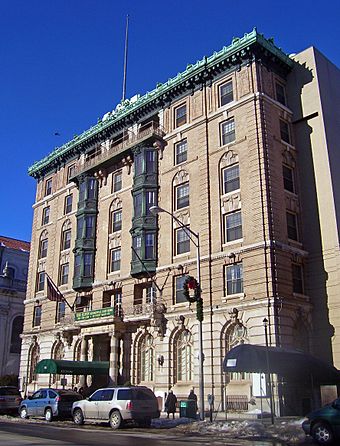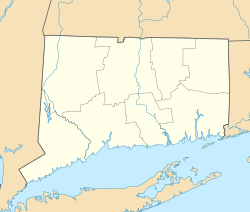Elton Hotel facts for kids
|
Elton Hotel
|
|
|
U.S. Historic district
Contributing property |
|

South elevation and partial east elevation, 2009
|
|
| Location | Waterbury, CT |
|---|---|
| Built | 1904 |
| Architect | Griggs & Hunt |
| Architectural style | Second Renaissance Revival, Beaux-Arts |
| Part of | Downtown Waterbury Historic District (ID83001280) |
| NRHP reference No. | 83001282 |
Quick facts for kids Significant dates |
|
| Added to NRHP | June 30, 1983 |
| Designated CP | August 3, 1983 |
The Elton Hotel is a historic building in downtown Waterbury, Connecticut. It was built in the early 1900s by local architects Griggs & Hunt. The hotel shows off the beautiful Second Renaissance Revival and Beaux-Arts styles.
This grand hotel was built in 1904. It replaced a fancy hotel that burned down in a big fire in 1902. Many important local business people invested in it. Surprisingly, the hotel made a profit in its very first year!
Many famous people stayed here. The writer F. Scott Fitzgerald was a guest. It's also believed that James Thurber wrote his famous story, "The Secret Life of Walter Mitty", while staying at the Elton.
Before the 1960 election, John F. Kennedy gave an important speech from the hotel. This speech helped him win Connecticut. The Elton Hotel was used as a hotel until the early 1970s.
Later, in 1983, the building was listed on the National Register of Historic Places. This means it's a very important historic site. Since then, it has been changed into offices and housing for seniors.
Contents
What Does the Hotel Look Like?
The Elton Hotel is on West Main Street in Waterbury. It's a large building on a corner lot. Across the street is Waterbury Green, a big park in the city center. Many other old buildings from the same time are nearby.
The hotel building is about 100 feet (30.5 m) square and six stories tall. It's made of a steel frame and covered in light brown brick. The front of the building sticks out a little.
Outside the Hotel
The first floor of the hotel is made of rough-looking limestone. It has round-arched windows with fancy carvings above them. The main entrance is in the middle, under a small roof.
A stone line separates the first and second floors. The second-story windows are smaller and rectangular. They have decorative carvings too. Some windows open onto a balcony with a pretty iron railing. The brickwork on the corners looks like stone blocks.
Another stone line divides the second and third floors. On these floors, you can see oriel windows covered in copper. These windows stick out from the building. They are decorated with small columns and fancy tops.
Other windows on the third and fourth floors are set inside slightly curved arches. They have stone decorations above them.
The fifth floor has bricks that stick out. The windows here are simpler. At the top of the copper oriel windows, there's another balcony, similar to the one on the second floor. On the sixth floor, some windows are French doors that open onto the balcony.
The roofline is also decorated with copper. It has large brackets and carvings that create a fancy edge. There are also copper designs with niches and cartouches. A flagpole stands in the center.
The side of the building facing Prospect Street looks similar. It has four sticking-out oriel windows that go up higher. The ground floor has a round-arched entrance and stained glass windows with shield-like designs.
The back of the building is plainer, with red brick and simple arched windows. The east side, facing a narrow alley, is somewhere in between. It has a U-shape with an open space for air. A copper railing is along the top of the first story, with a skylight behind it that once lit the dining room.
Inside the Hotel
The lobby of the hotel has some original features. There are Ionic columns with a unique pattern. These columns support a decorative band with alternating designs. Behind them, similar flat columns create a deep arched entryway. The walls have marble niches with flower carvings. The ceiling of the entryway has a large central panel with carved fruit and flowers.
The inside of the hotel has changed over time. The lobby's original columns and decorative edges have been painted. The beautiful marble floor and fireplaces are still there. One fireplace in an office has a 1930s mural showing Waterbury's industries.
The ballroom on the west side once had a curved ceiling with fancy molding. Most of this is now hidden by a modern ceiling. You can still see parts of it from a second-floor doorway. The stairways still have their original columns, arches, and plaster decorations. The upper floors have hallways with original door frames and rooms with original trim, including deep decorative edges and paneling.
A Look Back: The Hotel's Story
By 1900, Waterbury was known as "The Brass City" because of its large brass-making companies. The downtown buildings were very fancy, showing the city's success. But in 1902, a fire destroyed 42 buildings in the downtown area.
The city was sad, but not defeated. The fire gave them a chance to rebuild and make the city even better. Many important buildings, like the city's municipal center, were built after the fire.
One important building that burned down was the Scovill Hotel, the city's best. To replace it, important families from the brass industry, like the Scovills, put their money together. They raised $300,000 (which is like millions today!) to build a new, even fancier hotel for business travelers. They named it the Elton Hotel after J.S. Elton, who founded the Waterbury Brass Company and gave the most money.
Wilfred E. Griggs, a local architect, was chosen to design the hotel. He had already designed other unique buildings in the city. His design for the Elton Hotel was very elegant. It had many features of the Second Renaissance Revival style, like a flat roof and decorative edges. It also had classical stone carvings of flowers and fruits, which were common in Beaux-Arts buildings.
The hotel was very modern inside. It used new technologies like a steel frame structure, elevators, electric lights, and telephones in every room.
The investors didn't expect the hotel to make money right away. Their main goal was to give Waterbury a hotel as good as those in bigger cities. But surprisingly, it made a profit in its first year! Its restaurants were popular, and its ballroom became the place for all the city's most important social events.
Famous guests in the early 1900s included F. Scott Fitzgerald, Rosalind Russell, and Lefty Gomez. In the late 1930s, writer James Thurber lived nearby. He often visited Waterbury with his wife. These trips inspired his famous short story, "The Secret Life of Walter Mitty". This story is now considered a classic of American literature.
In the story, the main character, Walter Mitty, and his wife visit Waterbury. After finishing his errands, Mitty waits for his wife in a hotel lobby. While sitting in a leather chair, he starts daydreaming about being a combat pilot. It's believed that the hotel described in the story was the Elton.
On October 10, 1922, a group of 15 men met in the Elton's basement. They started Unico National, an Italian American service organization. This group helps with charity, supports education, and does patriotic deeds. Today, Unico National has over 7,000 members across 19 states. A plaque on the front of the building remembers this event.
In the late 1950s, the Elton Hotel was renamed the Roger Smith Hotel. On November 6, 1960, at 3 a.m., John F. Kennedy spoke to a huge crowd of about 40,000 people. They were gathered on the Green, and Kennedy spoke from the hotel's balcony. This was one of his last speeches before the election that year.
The large crowd and their excitement for Kennedy made state Democratic chairman John Moran Bailey predict that Kennedy would win Connecticut. Two days later, Connecticut voted for Kennedy by an even larger margin than predicted. This was the first time Connecticut had voted for a Democrat since 1944.
Pierre Salinger, Kennedy's press secretary, later called this the greatest night of the campaign. A special plaque was later put on the railing to remember it. In 1980, Ronald Reagan also spoke on the Green. He mentioned Kennedy's speech, connecting himself to the historic moment.
By the time Reagan visited, the Elton was no longer a hotel. It had been changed into offices. Today, it is called The Elton Residential Care, and it's a facility that helps seniors.



